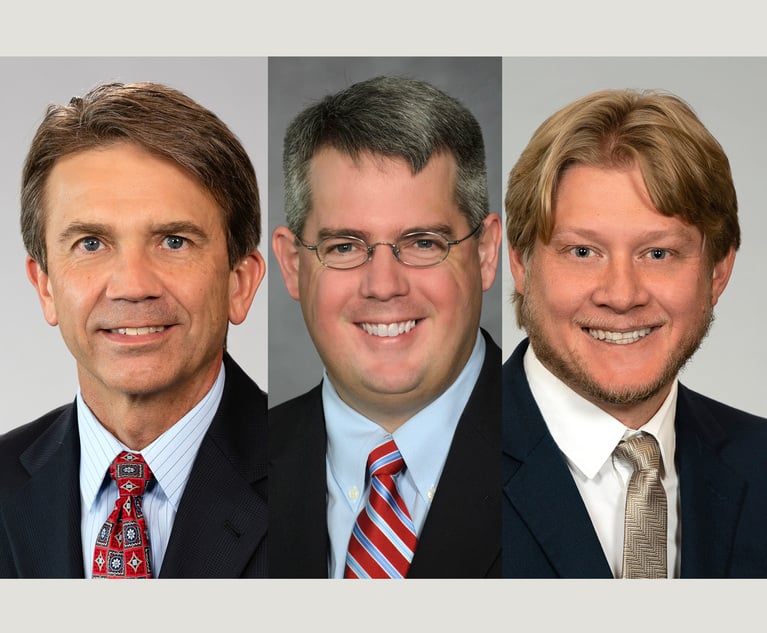 Justice Samuel Alito Jr. testifying before Congress in 2019. Credit: Diego M. Radzinschi / ALM
Justice Samuel Alito Jr. testifying before Congress in 2019. Credit: Diego M. Radzinschi / ALMJustices Sharply Divide Over When to Overturn Precedent
Justice Samuel Alito Jr.'s dissent began with his statement that "the doctrine of stare decisis gets rough treatment in today's decision."
April 20, 2020 at 03:17 PM
7 minute read
The original version of this story was published on National Law Journal
The U.S. Supreme Court on Monday did more than rule that the Sixth Amendment requires unanimous jury verdicts in state court criminal trials. In highly fractured opinions, the justices appeared to lay down markers on their future willingness to stand by divisive prior decisions, such as the landmark Roe v. Wade abortion ruling.
The justices's 6-3 decision in Ramos v. Louisiana provoked five separate opinions, with unusual lineups, focused primarily on whether to abide by so-called stare decisis—adherence to precedent—or to overrule the 1972 precedent in the case Apodaca v. Oregon, which allowed nonunanimous verdicts in felony criminal trials.
Justice Elena Kagan broke with her colleagues on the court's left to join Chief Justice John Roberts Jr. in signing onto the sole dissent by Justice Samuel Alito Jr. But Alito's dissent, heavily focused on stare decisis, went a step too far for Kagan in one important respect, keeping her from joining his opinion in full.
Justice Neil Gorsuch, who led the six-justice majority, lost Justices Clarence Thomas, Sonia Sotomayor and Brett Kavanaugh in a portion of his opinion that stated the Apodaca opinion had no "precedential force" because a single justice's view controlled that 4-1-4 decision.
Stare decisis—to stand by precedent—is not a rare issue in Supreme Court cases, but it is a flash point at times. This term, in another Louisiana case awaiting a decision—June Medical Services v. Russo—the justices will decide whether to apply, distinguish, narrow, or overrule their 2016 ruling in a nearly identical abortion-related case, Whole Woman's Health v. Hellerstedt.
The separate opinions in the jury case, with their focus on stare decisis, raise the question, "is the majority's opinion principally about unanimous juries or building a foundation for cases to come?" said former federal prosecutor John Marti, a partner at Dorsey & Whitney.
Gorsuch and Kavanaugh, he noted, were questioned closely in their Senate confirmation hearings about the future of Roe v. Wade. "Today, Justice Gorsuch noted 'it is something else entirely to perpetuate something we all know to be wrong only because we fear the consequences of being right.' Perhaps in this opinion, President Trump's appointees are foreshadowing the future reconsideration of Roe."
 Neil Gorsuch testifies at his confirmation hearing in March 2017. Credit: Diego M. Radzinschi/ NLJ
Neil Gorsuch testifies at his confirmation hearing in March 2017. Credit: Diego M. Radzinschi/ NLJ
In Monday's decision, Gorsuch called the Apodaca ruling an "admittedly mistaken" constitutional decision and "an outlier" from the start. "In arguing otherwise, the dissent must elide the reliance the American people place in their constitutionally protected liberties, overplay the competing interests of two States, count some of those interests twice, and make no small amount of new precedent all its own," Gorsuch wrote.
Kavanaugh, in an 18-page concurring opinion that elaborated on his view of stare decisis, said he would collapse into three broad categories the seven "somewhat elastic" factors that the court has used to determine whether to overrule precedents.
He wrote that he would ask: Is the prior decision grievously or egregiously wrong? Has the prior decision caused significant negative jurisprudential or real-world consequences? And, would overruling the prior decision unduly upset reliance interests?
In analyzing Apodaca in light of those three questions, Kavanaugh answered yes to all three.
 U.S. Supreme Court Justice Sonia Sotomayor. Credit: Diego M. Radzinschi/ National Law Journal.
U.S. Supreme Court Justice Sonia Sotomayor. Credit: Diego M. Radzinschi/ National Law Journal.
Sotomayor's approach to stare decisis in this case rested primarily on two key factors. She wrote that the force of stare decisis is "at its nadir" in cases involving criminal procedure rules. "While overruling precedent must be rare, this Court should not shy away from correcting its errors where the right to avoid imprisonment pursuant to unconstitutional procedures hangs in the balance," she wrote. Evangelisto Ramos was sentenced to life without parole after a nonunanimous jury conviction.
Sotomayor also looked to the legacy of racism that spurred the nonunanimous jury laws of Louisiana and Oregon and those two states' only recent efforts to address the laws' discriminatory purpose and effects by repealing them.
Justice Clarence Thomas, concurring in the judgment, reiterated his long-standing view that the Constitution's privileges and immunities clause is the proper channel for incorporating Bill of Rights guarantees to the states.
"I would simply hold that, because all of the opinions in Apodaca addressed the Due Process Clause, its Fourteenth Amendment ruling does not bind us because the proper question here is the scope of the Privileges or Immunities Clause," Thomas wrote. "I cannot understand why the court, having decided to abandon Apodaca, refuses to correctly root its holding in the Privileges or Immunities Clause."
Alito's dissent began with his statement that "the doctrine of stare decisis gets rough treatment in today's decision. Lowering the bar for overruling our precedents, a badly fractured majority casts aside an important and long-established decision with little regard for the enormous reliance the decision has engendered."
The reliance on Apodaca, which Alito called "massive and concrete," was the central focus of his dissent and he warned that Louisiana and Oregon would face "a tsunami" of litigation on the jury unanimity issue.
But where he lost Kagan was in the part of his opinion in which he claimed that "reliance in this case far outstrips that asserted in recent cases in which past precedents were overruled." Alito then named a long list of those cases, including decisions in which Kagan had dissented, notably the 2018 union fee case, Janus v. AFSCME, overruling a four-decade-old unanimous precedent and last year's decision in Knick v. Township of Scott. Kagan did not write separately in the jury case. Alito wrote the 5-4 majority opinion in Janus.
Alito concluded his dissent with, perhaps, a warning to his colleagues. "By striking down a precedent upon which there has been massive and entirely reasonable reliance, the majority sets an important precedent about stare decisis," he wrote. "I assume that those in the majority will apply the same standard in future cases."
The reliance of generations of women on the right to abortion is often used as an argument against overturning Roe and Planned Parenthood v. Casey.
Former federal prosecutor Harry Sandick, a partner at Patterson Belknap Webb & Tyler, agreed with Dorsey's Marti that the "real debate" in the jury decision is about treatment of stare decisis.
"Is stare decisis for 'suckers,' as a popular Supreme Court podcast says partly in jest, to be used by whichever side finds that the doctrine supports the outcome that they prefer?" asked Sandick in a statement. "Or is it something that has real weight in how a particular case turns out? These are important questions that relate to the public's perception of the legitimacy of the Court's decisions in a host of cases that implicate some of the most contested issues in our society, and at a time when the court's selection has been more influenced by constitutional hardball and political gamesmanship than ever before."
This content has been archived. It is available through our partners, LexisNexis® and Bloomberg Law.
To view this content, please continue to their sites.
Not a Lexis Subscriber?
Subscribe Now
Not a Bloomberg Law Subscriber?
Subscribe Now
NOT FOR REPRINT
© 2025 ALM Global, LLC, All Rights Reserved. Request academic re-use from www.copyright.com. All other uses, submit a request to [email protected]. For more information visit Asset & Logo Licensing.
You Might Like
View All
Let’s Hear It One Last Time!: One More Bow for 2024’s Litigators of the Week

Litigation Leaders: Greenspoon Marder’s Beth-Ann Krimsky on What Makes Her Team ‘Prepared, Compassionate and Wicked Smart’

Litigators of the Week: After a 74-Day Trial, Shook Fends Off Claims From Artist’s Heirs Against UMB Bank
Law Firms Mentioned
Trending Stories
- 1'Pull Back the Curtain': Ex-NFL Players Seek Discovery in Lawsuit Over League's Disability Plan
- 2Tensions Run High at Final Hearing Before Manhattan Congestion Pricing Takes Effect
- 3Improper Removal to Fed. Court Leads to $100K Bill for Blue Cross Blue Shield
- 4Michael Halpern, Beloved Key West Attorney, Dies at 72
- 5Burr & Forman, Smith Gambrell & Russell Promote More to Partner This Year
Who Got The Work
Michael G. Bongiorno, Andrew Scott Dulberg and Elizabeth E. Driscoll from Wilmer Cutler Pickering Hale and Dorr have stepped in to represent Symbotic Inc., an A.I.-enabled technology platform that focuses on increasing supply chain efficiency, and other defendants in a pending shareholder derivative lawsuit. The case, filed Oct. 2 in Massachusetts District Court by the Brown Law Firm on behalf of Stephen Austen, accuses certain officers and directors of misleading investors in regard to Symbotic's potential for margin growth by failing to disclose that the company was not equipped to timely deploy its systems or manage expenses through project delays. The case, assigned to U.S. District Judge Nathaniel M. Gorton, is 1:24-cv-12522, Austen v. Cohen et al.
Who Got The Work
Edmund Polubinski and Marie Killmond of Davis Polk & Wardwell have entered appearances for data platform software development company MongoDB and other defendants in a pending shareholder derivative lawsuit. The action, filed Oct. 7 in New York Southern District Court by the Brown Law Firm, accuses the company's directors and/or officers of falsely expressing confidence in the company’s restructuring of its sales incentive plan and downplaying the severity of decreases in its upfront commitments. The case is 1:24-cv-07594, Roy v. Ittycheria et al.
Who Got The Work
Amy O. Bruchs and Kurt F. Ellison of Michael Best & Friedrich have entered appearances for Epic Systems Corp. in a pending employment discrimination lawsuit. The suit was filed Sept. 7 in Wisconsin Western District Court by Levine Eisberner LLC and Siri & Glimstad on behalf of a project manager who claims that he was wrongfully terminated after applying for a religious exemption to the defendant's COVID-19 vaccine mandate. The case, assigned to U.S. Magistrate Judge Anita Marie Boor, is 3:24-cv-00630, Secker, Nathan v. Epic Systems Corporation.
Who Got The Work
David X. Sullivan, Thomas J. Finn and Gregory A. Hall from McCarter & English have entered appearances for Sunrun Installation Services in a pending civil rights lawsuit. The complaint was filed Sept. 4 in Connecticut District Court by attorney Robert M. Berke on behalf of former employee George Edward Steins, who was arrested and charged with employing an unregistered home improvement salesperson. The complaint alleges that had Sunrun informed the Connecticut Department of Consumer Protection that the plaintiff's employment had ended in 2017 and that he no longer held Sunrun's home improvement contractor license, he would not have been hit with charges, which were dismissed in May 2024. The case, assigned to U.S. District Judge Jeffrey A. Meyer, is 3:24-cv-01423, Steins v. Sunrun, Inc. et al.
Who Got The Work
Greenberg Traurig shareholder Joshua L. Raskin has entered an appearance for boohoo.com UK Ltd. in a pending patent infringement lawsuit. The suit, filed Sept. 3 in Texas Eastern District Court by Rozier Hardt McDonough on behalf of Alto Dynamics, asserts five patents related to an online shopping platform. The case, assigned to U.S. District Judge Rodney Gilstrap, is 2:24-cv-00719, Alto Dynamics, LLC v. boohoo.com UK Limited.
Featured Firms
Law Offices of Gary Martin Hays & Associates, P.C.
(470) 294-1674
Law Offices of Mark E. Salomone
(857) 444-6468
Smith & Hassler
(713) 739-1250







